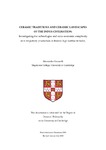This
thesis explores the technological choices made by rural communities of
the Indus Civilisation (c.2600-1900BC) by analysing ceramic materials
from three villages in north-west India. The Indus Civilisation has
typically been characterised as a society that underwent a broadly
homogeneous development, and continuity and transformations of ceramic
industries have previously been studied through the use of relatively
simplified models of diffusion. The small number of large-scale
settlements that are referred to as cities have typically been used to
characterise the technological, social and cultural behaviours across
the vast zone occupied by Indus Civilisation populations. Within this
region, the processes of urbanisation and deurbanisation are much
debated, and it has been suggested that climate change played a role in
socio-cultural transformations. However, rural dynamics, including
lifestyles, craft production and knowledge-scapes are often perceived as
being marginal. The rural settlements that have been studied are
located at varying distances from large-scale sites, each showing a
range of phases of occupation chronologically spanning from the early
phases of Indus urban development, to the late urban and post-urban
phases. The diversity of settlements has made it possible to explore the
impact of societal and climatic changes on ceramic industries, and to
assess how communities interacted with variable environments, as well as
their technological transformations over time. Through the use of
macroscopic and archaeometric analyses of pottery, integrated with
ethno-archaeological observations, Indus ceramic traditions have been
identified within the rural context. Here craft traditions are presented
as a medium for understanding the functional variability of ceramics,
as well as the variability of associated socio-cultural groups
characterising each site. This approach has made it possible to
reconstruct more diverse industries than previously thought, and offered
a glimpse into synchronic Indus social networks among villages, as well
as their diachronic transformations. The resulting picture suggests
that rural social complexity and interactions facilitated the
reproduction of a resilient, adaptable, yet mutating system of ceramic
traditions. These traditions partially transformed during the Indus
Civilisation’s phases of urbanisation and deurbanisation. Rural ceramic
landscapes adapted to, and were enriched by broader variable social and
physical environments, yet maintained their own characteristics and
identities.
Keywords
archaeology, indus, indus civilisation, harappa, ceramic, pottery,
petrography, ethnography, india, South Asia, ceramic analysis,
archaeometry, chemistry, chaînes opératoires
Rights
All rights reserved, All rights reserved, All rights reserved, All
rights reserved, All rights reserved, All rights reserved, All rights
reserved, All rights reserved, All rights reserved, All rights reserved,
All rights reserved, All rights reserved
Licence:
http://www.rioxx.net/licenses/all-rights-reserved










 Stumble It!
Stumble It!

No comments:
Post a Comment